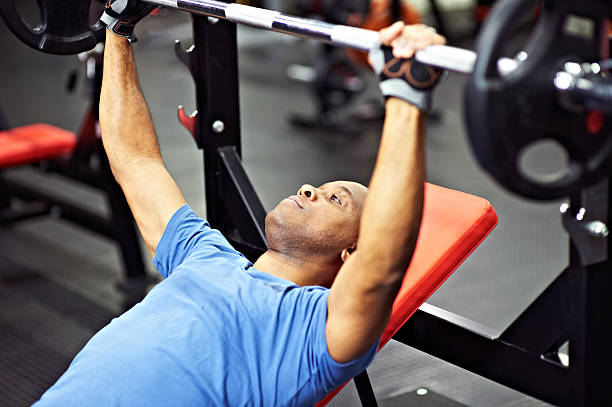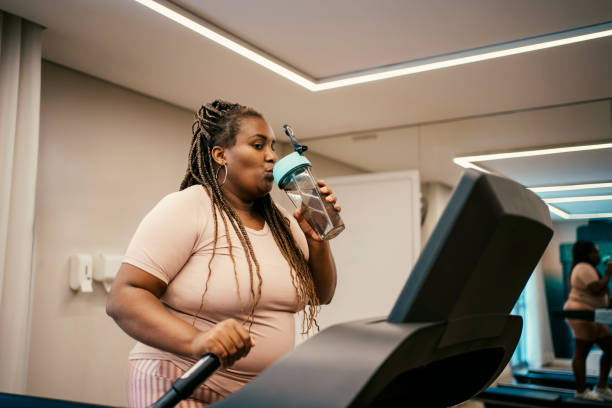(BlackFitness101.com) When it comes to building a powerful, well-defined chest, the importance of targeted exercises cannot be overstated. A strong chest not only enhances your physical appearance but also contributes to overall upper body strength, stability, and functional performance. As a fitness trainer with years of experience helping individuals achieve their fitness goals, I can confidently say that focusing on the right chest exercises can significantly boost your strength, enhance muscle definition, and improve your overall fitness.
In this article, I’ll walk you through three chest exercises that are essential for anyone looking to build a stronger chest. I’ll delve into the mechanics of each exercise, explain their benefits, and provide tips on how to perform them correctly to maximize results. Whether you’re a beginner or an experienced lifter, incorporating these exercises into your routine will help you feel stronger and more confident in your workouts.

1. Barbell Bench Press
The Barbell Bench Press is often referred to as the king of chest exercises, and for good reason. It’s a compound movement that engages multiple muscle groups, primarily targeting the pectoralis major, along with secondary activation of the triceps and anterior deltoids. The Barbell Bench Press is a fundamental exercise that has stood the test of time due to its effectiveness in building chest strength and size.
Mechanics and Technique:
- Starting Position: Lie flat on a bench with your feet firmly planted on the floor. Your back should be slightly arched, and your shoulder blades should be retracted (pulled together) to provide stability and protect your shoulder joints.
- Grip: Grasp the barbell with a grip slightly wider than shoulder-width. Your palms should face forward, and your wrists should be aligned with your forearms.
- Lowering the Bar: Slowly lower the barbell toward your chest, keeping your elbows at a 45-degree angle to your torso. The bar should come to a halt just above your chest, in line with your nipples.
- Pressing the Bar: Press the barbell upward in a controlled manner, fully extending your arms without locking out your elbows. Focus on squeezing your chest muscles at the top of the movement.
- Breathing: Inhale as you lower the barbell, and exhale as you press it back up.
Benefits of the Barbell Bench Press:
- Strength Gains: The Barbell Bench Press allows you to lift heavy weights, making it a key exercise for developing maximal strength in the chest.
- Muscle Hypertrophy: This exercise effectively targets the pectoral muscles, promoting muscle growth and definition.
- Upper Body Stability: The compound nature of the movement engages stabilizing muscles, improving overall upper body stability and coordination.
Tips for Maximizing Results:
- Progressive Overload: Gradually increase the weight you lift to challenge your muscles and stimulate growth. Ensure you maintain proper form to prevent injury.
- Mind-Muscle Connection: Focus on feeling the contraction in your chest muscles as you press the barbell. This connection can enhance muscle activation and effectiveness.
- Varying Grip Widths: Experiment with different grip widths to target different parts of the chest. A wider grip emphasizes the outer chest, while a narrower grip targets the inner chest and triceps.
Common Mistakes to Avoid:
- Flaring Elbows: Avoid flaring your elbows out too wide, as this can put undue stress on your shoulder joints and increase the risk of injury.
- Bouncing the Bar: Don’t bounce the bar off your chest; instead, lower it in a controlled manner to fully engage the chest muscles.
- Overarching the Back: While a slight arch in your back is necessary for stability, avoid excessive arching, which can strain your lower back.
2. Dumbbell Flyes
Dumbbell Flyes are an excellent isolation exercise that targets the chest muscles, particularly the pectoralis major. Unlike the Barbell Bench Press, which involves multiple muscle groups, Dumbbell Flyes focus specifically on stretching and contracting the chest muscles, making them a valuable addition to any chest workout routine.
Mechanics and Technique:
- Starting Position: Lie flat on a bench with a dumbbell in each hand. Your feet should be planted on the floor for stability, and your back should remain flat on the bench.
- Grip: Hold the dumbbells with your palms facing each other, directly above your chest. Your elbows should be slightly bent to reduce stress on your joints.
- Lowering the Dumbbells: Slowly lower the dumbbells out to the sides, keeping your elbows slightly bent throughout the movement. Lower the weights until your chest feels a deep stretch, but not so far that your arms are parallel to the floor.
- Bringing the Dumbbells Together: Bring the dumbbells back together in a controlled manner, focusing on squeezing your chest muscles as you return to the starting position.
- Breathing: Inhale as you lower the dumbbells and exhale as you bring them back together.
Benefits of Dumbbell Flyes:
- Chest Isolation: Dumbbell Flyes allow you to isolate the chest muscles more effectively than compound exercises, helping to enhance muscle definition and shape.
- Improved Flexibility: The stretching motion of Dumbbell Flyes increases flexibility in the chest and shoulder muscles.
- Mind-Muscle Connection: This exercise encourages a strong mind-muscle connection, which is crucial for maximizing muscle engagement and growth.
Tips for Maximizing Results:
- Controlled Movements: Perform the exercise slowly and with control to fully engage the chest muscles and avoid unnecessary strain on the shoulder joints.
- Range of Motion: Focus on achieving a full range of motion to maximize the stretch and contraction of the chest muscles. However, avoid overstretching, which can lead to injury.
- Moderate Weights: Use moderate weights that allow you to maintain proper form and control throughout the exercise. Overloading with heavy weights can compromise your technique and reduce effectiveness.
Common Mistakes to Avoid:
- Locking Elbows: Avoid locking your elbows at the bottom of the movement, as this can place excessive stress on the joints and increase the risk of injury.
- Overstretching: Don’t lower the dumbbells too far, as this can strain your shoulder joints and reduce the effectiveness of the exercise.
- Using Momentum: Focus on using your chest muscles to lift the dumbbells rather than relying on momentum. This ensures that you’re fully engaging the target muscles.
3. Push-Ups
Push-Ups are a classic bodyweight exercise that can be performed anywhere, making them a versatile and effective addition to any chest workout routine. Push-Ups primarily target the pectoralis major but also engage the triceps, shoulders, and core muscles, providing a full upper body workout.
Mechanics and Technique:
- Starting Position: Begin in a plank position with your hands placed slightly wider than shoulder-width apart. Your body should form a straight line from your head to your heels, with your core engaged and your back flat.
- Lowering Your Body: Slowly lower your body toward the floor by bending your elbows, keeping them close to your body. Lower yourself until your chest is just above the ground, maintaining a straight line from head to heels.
- Pushing Up: Push through your palms to raise your body back to the starting position, fully extending your arms without locking out your elbows.
- Breathing: Inhale as you lower your body and exhale as you push back up.
Benefits of Push-Ups:
- Functional Strength: Push-Ups improve functional strength by mimicking movements used in daily activities and sports.
- Core Stability: Push-Ups engage the core muscles, helping to build stability and prevent lower back injuries.
- Scalable Exercise: Push-Ups can be modified to suit different fitness levels, making them accessible to beginners and challenging for advanced athletes.
Tips for Maximizing Results:
- Maintain Proper Form: Keep your body in a straight line throughout the movement. Avoid sagging your hips or raising your buttocks, as this can reduce the effectiveness of the exercise and strain your lower back.
- Varying Hand Positions: Experiment with different hand placements to target different areas of the chest. A wider hand position emphasizes the outer chest, while a narrower position targets the triceps and inner chest.
- Progression: As you become stronger, progress to more challenging variations such as decline push-ups, one-arm push-ups, or adding weight (e.g., wearing a weighted vest) to increase resistance.
Common Mistakes to Avoid:
- Sagging Hips: Avoid letting your hips sag toward the ground, as this can strain your lower back and reduce the effectiveness of the exercise.
- Flaring Elbows: Keep your elbows close to your body to protect your shoulder joints and engage the chest muscles more effectively.
- Incomplete Range of Motion: Lower your body until your chest is just above the ground to ensure a full range of motion and maximize muscle engagement.
Incorporating these three chest exercises—Barbell Bench Press, Dumbbell Flyes, and Push-Ups—into your workout routine can significantly enhance your chest strength and muscle definition. Each exercise offers unique benefits and targets the chest muscles in different ways, ensuring a well-rounded and effective chest workout.
Remember, consistency and proper form are key to achieving the best results. Focus on progressive overload, maintain a strong mind-muscle connection, and always prioritize safety by using the correct technique. Whether you’re aiming to build muscle mass, increase strength, or improve overall upper body fitness, these exercises will help you feel stronger and more confident in your training journey.
As a fitness trainer, I encourage you to start incorporating these exercises into your routine and experience the powerful impact they can have on your chest development. Stay committed, push yourself, and enjoy the rewards of a stronger, more defined chest.
Staff Writer; Janet Banks
Questions? Feel free to email me at; JBanks@BlackFitness101.com.












Leave a Reply